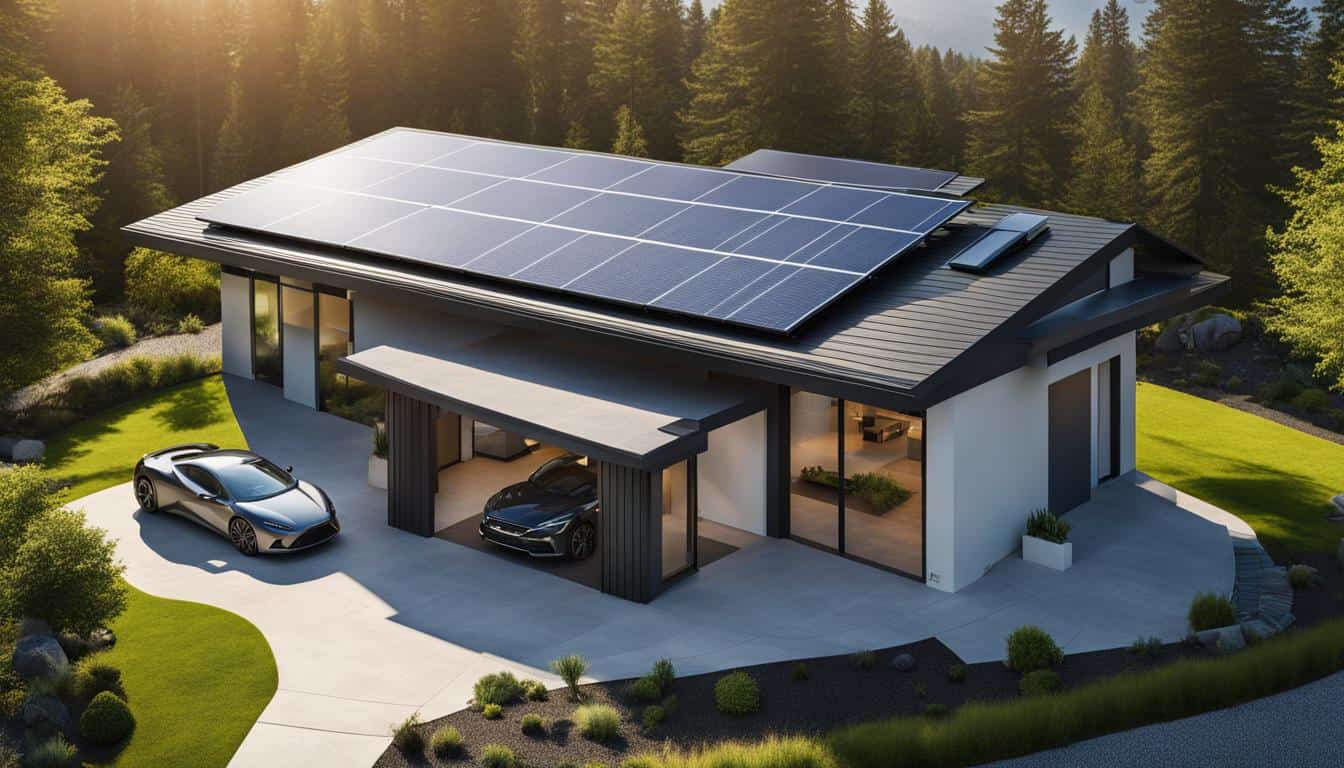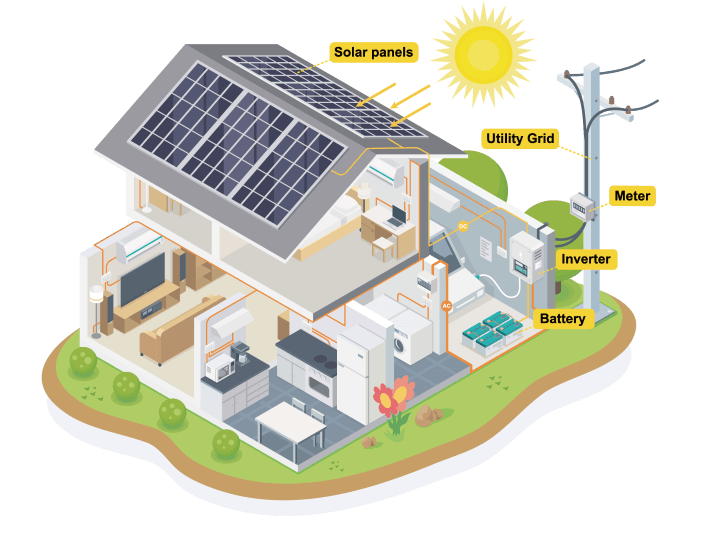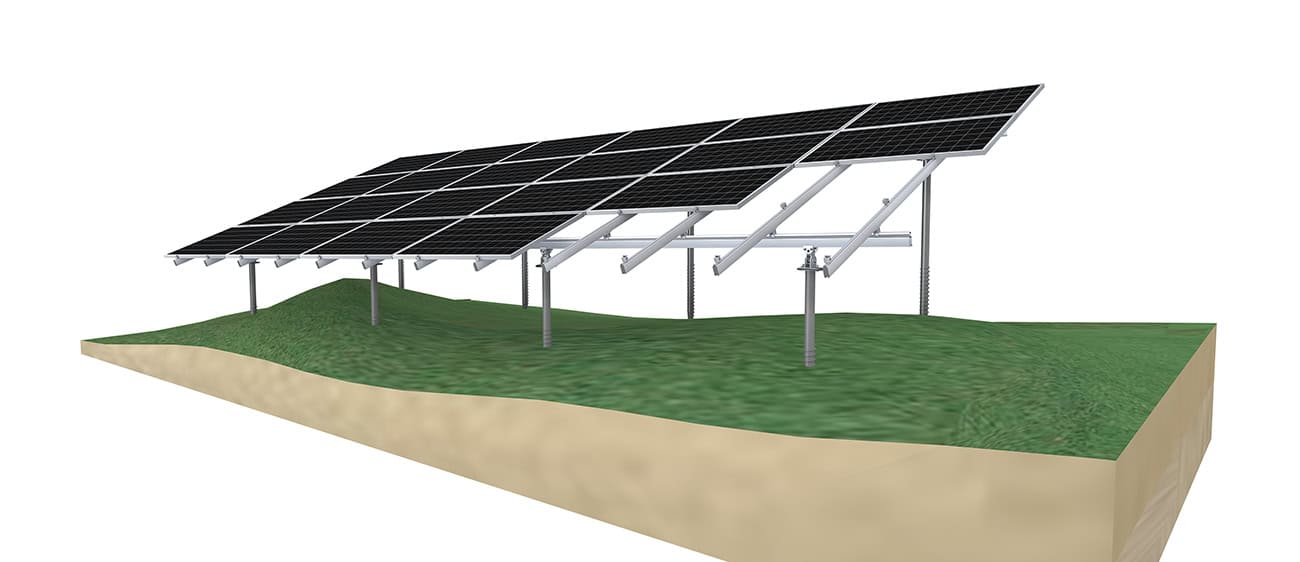하이브리드 태양광 인버터 소개
하이브리드 태양광 인버터의 세계는 기술과 실용성이 만나는 영역으로 접어들고 있습니다. 이러한 장치는 태양 에너지를 활용하는 데 중추적인 역할을 하며, 태양 광선을 사용 가능한 전기로 변환하여 일상 생활에 필요한 전력을 공급합니다. 또한 태양이 비추지 않을 때를 대비해 여분의 에너지를 배터리에 저장하는 효율적인 관리자의 역할도 합니다.
하이브리드 인버터는 전력망의 안정성에 관계없이 현대 생활의 사치를 중단 없이 유지할 수 있도록 도와주는 절제된 챔피언입니다. 백그라운드에서 조용히 작동하며 기존 발전기와 관련된 소음과 공해 없이 지속 가능한 에너지 솔루션을 제공합니다.
이 소개 섹션에서는 하이브리드 태양광 인버터의 복잡성을 자세히 살펴보고, 이를 구동하는 혁신에 대해 알아볼 것입니다. 지속 가능한 삶을 촉진하는 데 있어 인버터의 역할과 재정적 이점, 그리고 더 친환경적인 지구에 기여하는 방법에 대해 살펴볼 것입니다. 이러한 시스템은 재생 에너지를 수용하는 것뿐만 아니라 우리가 포착한 에너지의 효율성을 극대화하는 것이기도 합니다.
기술적인 내용을 자세히 살펴보고 이 현대 에너지의 거장들의 매력적인 장점을 발견할 준비를 하세요. 각 단락을 통해 태양광 인버터가 어떻게 모든 가정이 태양열로 전력을 공급받을 수 있는 미래를 만들어가는지 더 깊이 이해할 수 있습니다.
이 논의에서 다루는 하이브리드 인버터는 특히 전력을 그리드에 다시 공급하도록 설계된 그리드 연계형 인버터라는 점에 유의하시기 바랍니다. 일부에서 그리드에서 전력을 공급받을 수 있는 "오프 그리드" 인버터라고 부르는 것과는 구별하는 것이 중요하며, 이는 현재 주제의 초점이 아닙니다.
하이브리드 태양광 인버터의 기능
에너지 변환 과정에서 인버터의 역할에 대해 알아보세요. 태양광 패널은 태양 광선을 활용하여 직류(DC)로 변환하는 최전방 전사입니다. 인버터는 태양광 패널의 전력을 가정과 사무실에 전력을 공급하는 전기 형태인 교류(AC)로 변환하는 핵심 역할을 합니다.
하이브리드 태양광 인버터의 기능은 단순한 변환 그 이상입니다. 태양광 패널이 최대 햇빛을 받아 즉각적인 소비량보다 더 많은 에너지를 생산하면 인버터는 이 잉여 에너지를 스마트하게 경로를 변경하여 배터리를 충전합니다. 이 에너지 저장 시스템은 시스템의 안전장치로서 해가 져도 지속적인 전력 공급을 보장합니다.
야간이나 태양광 생산량이 부족한 피크 수요 시간대에는 인버터가 기어를 전환하여 배터리에 저장된 에너지를 활용합니다. 이는 중단 없이 일관된 전력 공급을 유지하는 원활한 전환입니다. 배터리 전력이 고갈되면 하이브리드 인버터가 중단되지 않고 그리드에서 전력을 끌어와 부족분을 보충할 수 있습니다.
일부 하이브리드 태양광 인버터에는 레트로핏 기능이 있어 전면적인 점검 없이 기존 태양광 시스템에 통합할 수 있습니다. 이 기능은 이미 태양광 발전 시스템에 투자한 상태에서 태양 전지 저장 장치로 업그레이드하거나 효율을 개선하려는 사람들에게 특히 매력적입니다.
최신 태양광 하이브리드 인버터에는 지능형 태양광 모니터링 소프트웨어가 장착되어 있어 태양광 에너지 생산 및 사용에 대한 실시간 인사이트를 제공합니다. 이러한 시스템은 에너지 흐름에 대한 포괄적인 개요를 제공하여 전력 소비를 효율적으로 관리하고 최적화할 수 있습니다.
이러한 유형의 인버터는 태양광과 배터리 스토리지를 모두 관리할 수 있는 이중 기능으로 인해 올인원 태양광 인버터라고 불리며, 기존 인버터에서 크게 도약한 제품입니다. 여분의 에너지가 낭비되지 않도록 보장하고 안정적인 백업을 제공함으로써 에너지에 민감한 가정과 기업 모두에게 현명한 투자가 될 수 있습니다.
기존 태양광 인버터에 비해 하이브리드 태양광 인버터의 장점
하이브리드 태양광 인버터는 기존 모델보다 향상된 기능을 제공하여 에너지 관리의 새로운 시대를 열었습니다. 가장 매력적인 장점 중 하나는 에너지를 저장하여 백업 전력을 공급할 수 있다는 점입니다. 태양광 전력을 즉시 사용할 수 있도록 변환하는 데 제한이 있는 기존 스트링 인버터와 달리 하이브리드 모델은 잉여 전력을 태양전지 시스템으로 보내 나중에 사용할 수 있습니다. 따라서 생성된 에너지를 보다 효율적으로 사용하여 정전이나 요금이 가장 높은 시간대에 전력을 공급하고 전력망에 대한 의존도를 줄일 수 있습니다.
또 다른 중요한 이점은 에너지 비용 절감입니다. 해가 진 후에도 태양광 에너지를 저장하고 사용할 수 있는 하이브리드 인버터는 가정과 기업이 태양광 투자를 극대화하고 전기 요금을 최소화할 수 있도록 도와줍니다. 이는 재정적으로 절약할 수 있을 뿐만 아니라 탄소 발자국도 줄일 수 있어 환경적으로도 건전합니다.
하이브리드 그리드 타이 인버터는 또한 에너지 관리에서 높은 유연성을 보여줍니다. 태양광 사용의 우선순위를 정하거나, 배터리에서 전력을 끌어오거나, 가장 경제적일 때 그리드 전력을 사용하도록 프로그래밍할 수 있습니다. 이러한 지능형 에너지 분배는 태양광 발전 시스템의 전반적인 효율성을 크게 향상시킬 수 있습니다.
설치 측면에서 하이브리드 인버터는 표준 계통 연계형 인버터와 배터리 인버터의 기능을 단일 장치로 결합하여 태양광 발전 시스템의 아키텍처를 단순화합니다. 이러한 통합은 초기 투자 비용과 시스템의 복잡성을 모두 줄여 유지보수가 용이하고 향후 업그레이드가 용이합니다.
또한 태양광 하이브리드 계통 연계 인버터는 미래 에너지 트렌드를 염두에 두고 설계되었습니다. 재생 에너지원의 채택이 증가함에 따라 다른 형태의 재생 에너지, 스마트 홈 기술, 심지어 전기 자동차와 통합할 수 있는 능력이 점점 더 중요해지고 있습니다. 하이브리드 인버터는 이러한 통합의 최전선에 서서 새로운 기술과 에너지 수요에 적응할 수 있는 다목적 솔루션을 제공합니다.
하이브리드 인버터와 함께 제공되는 지능형 모니터링 시스템은 사용자에게 에너지 패턴에 대한 자세한 인사이트를 제공합니다. 이를 통해 소비자는 에너지 사용에 대해 정보에 입각한 결정을 내릴 수 있는 지식을 확보할 수 있으며, 이는 추가적인 최적화 및 비용 절감으로 이어집니다.
태양광 패널 시스템과 통합
하이브리드 태양광 인버터 시스템의 다용도성은 태양광 발전으로 전환하는 가정이나 사업체의 판도를 바꿀 수 있는 요소입니다. 다양한 에너지원의 밀물과 썰물에 쉽게 적응할 수 있습니다. 이러한 다각적인 접근 방식은 에너지 안정성과 전력망으로부터의 독립성을 크게 강화할 수 있습니다.
또한 하이브리드 인버터는 진화하는 재생 에너지 환경에 맞춰 미래에 대비할 수 있도록 설계되었습니다. 스마트 홈과 사물 인터넷(IoT)이 부상하면서 이러한 장치는 다양한 센서 및 시스템과 통신하여 에너지 사용을 최적화하고 더 스마트하고 효율적인 가정과 건물에 기여할 수 있도록 설계되었습니다.
태양광 인버터와 태양전지 저장 시스템의 통합은 특히 주목할 만합니다. 태양전지는 친환경 에너지의 저장고 역할을 하며, 하이브리드 인버터는 이 저장된 에너지를 최대한 활용할 수 있도록 합니다. 피크 수요 또는 태양광이 에너지를 생산하지 않을 때 인버터는 이 예비 에너지를 끌어와 에너지 소비 곡선을 평평하게 하고 에너지 그리드에 더 안정적이고 덜 부담을 주는 데 기여합니다.
또한 하이브리드 태양광 인버터는 전기 자동차(EV)를 가정용 에너지 시스템에 통합하기 위한 디딤돌 역할을 하고 있습니다. 전기차 보급이 확대됨에 따라 태양광으로 효율적으로 충전할 수 있는 능력이 무엇보다 중요해질 것입니다. 하이브리드 인버터는 EV 충전기로의 에너지 흐름을 관리하여 태양광 사용의 우선순위를 정하고 운송의 전반적인 지속 가능성을 향상시킬 수 있습니다.
대규모 그리드 맥락에서 하이브리드 인버터는 전압 및 주파수 조정과 같은 보조 서비스를 제공함으로써 안정성에 기여할 수 있습니다. 분산형 에너지 자원 시스템의 일부로서 특히 재생 에너지 발전량이 많을 때 그리드의 균형을 유지하여 안정적인 전력 공급을 보장하고 재생 에너지 기반 전력 인프라로의 전환을 지원할 수 있습니다.
하이브리드 태양광 인버터를 재생 에너지 시스템에 통합하는 것은 혁신과 실용성을 결합한 에너지 관리에 대한 미래 지향적인 접근 방식을 의미합니다. 하이브리드 태양광 인버터는 다양한 재생 에너지원, 저장 시스템, 소비 수요 간의 조화로운 균형을 조율하여 더 깨끗하고 스마트하며 자급자족 가능한 에너지의 미래를 위한 길을 열어주는 지휘자 역할을 합니다.
하이브리드 인버터 시스템 도입의 경제적 이점

하이브리드 태양광을 도입하는 것은 재생 에너지의 세계에서 스위스 군용 칼을 선택하는 것에 비유할 수 있는데, 다용도성뿐만 아니라 상당한 경제적 이점을 제공하는 다기능 도구입니다. 하이브리드 시스템에 대한 초기 투자는 무료 태양 에너지 사용을 극대화하여 전기 요금을 절감할 수 있기 때문에 시간이 지남에 따라 수익을 창출할 수 있습니다.
가장 즉각적인 재정적 이점 중 하나는 에너지 비용 절감입니다. 태양광 패널의 잉여 에너지를 저장함으로써 가정과 기업에서는 전력 요금이 가장 비싼 피크 요금 시간대에 에너지를 사용할 수 있습니다. 이러한 '에너지 전환' 기능은 높은 전기 요금을 피할 수 있으며, 특히 에너지 비용이 높거나 가격 변동성이 큰 지역에 거주하는 사람들에게는 상당한 비용 절감 효과를 가져다 줄 수 있습니다.
또한 하이브리드 시스템은 재생 에너지를 장려하기 위한 다양한 정부 인센티브와 리베이트를 받을 수 있는 경우가 많습니다. 이러한 재정적 인센티브는 초기 비용을 크게 상쇄하고 투자 수익을 가속화할 수 있습니다. 경우에 따라 인센티브와 에너지 절약의 조합으로 투자 회수 기간이 놀라울 정도로 짧아질 수 있어 재정적인 측면에서 친환경 전환이 더욱 매력적으로 다가올 수 있습니다.
하이브리드 시스템의 수명과 내구성은 경제성에도 기여합니다. 기존 발전기보다 움직이는 부품 수가 적고 에너지 흐름을 효율적으로 관리할 수 있기 때문에 수명이 길고 유지보수가 덜 필요한 경우가 많습니다. 이러한 신뢰성은 교체 비용과 가동 중단 시간을 줄여 안정적이고 예측 가능한 에너지 공급을 보장합니다.
마지막으로, 하이브리드 태양광 시스템을 사용하면 부동산 가치를 높일 수 있습니다. 현대적이고 효율적인 재생 에너지 시스템을 갖춘 주택이나 상업용 건물은 지속가능성에 대한 노력과 낮은 유틸리티 비용에 대한 약속을 반영하여 구매자에게 더 매력적으로 다가갈 수 있습니다.
요컨대, 하이브리드 태양광의 경제적 이점은 개인에서 전 세계로 확대되어 재정적 인센티브와 환경적 책임을 일치시킵니다. 장기적인 비용 절감과 광범위한 경제적 이점을 고려하면 하이브리드 태양광 인버터가 지구를 위한 현명한 선택일 뿐만 아니라 주머니 사정을 위해서도 현명한 선택이라는 것이 분명해집니다.
기술 사양 및 호환성
올바른 하이브리드 인버터를 선택하는 데 있어 중요한 요소 중 하나는 기존 또는 계획된 태양광 발전 설정과의 호환성을 이해하는 것입니다.
고려해야 할 주요 사양은 일반적으로 킬로와트(kW) 단위로 측정되는 인버터의 전력 등급입니다. 이 정격은 태양광 어레이의 피크 전력 출력과 일치하거나 초과해야 에너지가 낭비되지 않습니다. 인버터의 전압 및 전류 입력 범위는 효율적인 에너지 변환을 보장하기 위해 태양광 어레이의 출력과 일치해야 하므로 가장 중요한 요소입니다.
인버터의 최대 효율은 사용 가능한 전기로 변환되는 태양광의 비율을 나타내는 성능의 벤치마크입니다. 효율이 높을수록 더 많은 태양 전력이 활용되어 태양광 시스템의 전반적인 생산성이 향상됩니다. 또한 인버터의 자체 소비 또는 작동에 사용되는 에너지를 최소화하여 순 에너지 절감을 극대화해야 합니다.
배터리 호환성은 또 다른 중요한 기술적 측면입니다. 태양광 그리드 타이 인버터는 특정 유형 및 용량의 배터리와 함께 작동하도록 설계되었습니다. 납산, 리튬 이온 또는 기타 기술에 관계없이 인버터와 배터리가 잘 맞는지 확인하는 것은 시스템의 성능과 수명을 최적화하는 데 매우 중요합니다.
온도 범위는 종종 간과되지만 매우 중요한 사양입니다. 하이브리드 인버터는 효율 손실이나 손상 없이 작동 환경의 극한 온도를 견딜 수 있어야 합니다. 열악한 조건에서도 최적의 성능을 유지하기 위해 열 관리 시스템이 함께 제공되는 경우가 많습니다.
인버터의 안티아일랜딩 보호, 접지 오류 감지, 과부하 보호와 같은 보호 기능은 시스템이 안전한 매개변수 내에서 작동하도록 하는 안전 필수 요소입니다. 이러한 기능은 인버터뿐만 아니라 연결된 장치와 그리드를 전력 생산 또는 소비의 불규칙성으로 인한 잠재적 손상으로부터 보호합니다.
마지막으로, 인버터의 통신 기능은 에너지 사용을 모니터링하고 관리하는 데 필수적입니다. 많은 최신 태양광용 하이브리드 인버터에는 홈 자동화 시스템에 연결하고 원격으로 제어할 수 있는 스마트 기능이 탑재되어 있습니다. 이러한 연결성을 통해 사용자는 실시간 데이터를 기반으로 에너지 소비를 최적화하고 변화하는 에너지 수요에 맞게 설정을 조정할 수 있습니다.
요약하자면 하이브리드 인버터의 기술 사양은 태양광 패널, 배터리 및 작동 환경과의 호환성을 결정하며 시스템의 효율성과 안전성에 중추적인 역할을 합니다. 이는 숫자와 기능이 조화를 이룰 때 재생 에너지 효율의 교향곡을 이끌어낼 수 있는 기술적 춤과도 같습니다.
미래
미래를 내다볼 때, 이러한 시스템을 더욱 효율적이고 접근 가능하며 에너지 솔루션에 필수적인 요소로 만들 수 있는 발전으로 가득 찬 지평선을 볼 수 있습니다.
인버터 기술의 혁신
가장 기대되는 발전 중 하나는 인공 지능(AI)과 머신 러닝의 통합입니다. 이러한 스마트 인버터는 전력 분배를 관리할 뿐만 아니라 에너지 소비 패턴을 예측하고 그에 따라 배터리 충전과 방전을 최적화합니다. 이는 태양 에너지를 더욱 효율적으로 사용하고 낭비를 줄일 수 있음을 의미합니다.
또한, 부품의 소형화 추세로 인해 인버터가 더욱 작아지고 설치가 쉬워질 것으로 보입니다. 이는 주택 소유주들에게 설치의 용이성이 덜 부담스러워짐에 따라 더 많은 주택 고객에게 시장이 열릴 것입니다.
배터리 기술도 더 효율적이고 오래 지속되며 안전한 솔리드 스테이트 배터리의 개발과 함께 빠르게 발전하고 있습니다. 이는 하이브리드 태양광 에너지 시스템의 저장 기능을 강화하여 기상 조건에 관계없이 필요할 때 태양광 전력을 사용할 수 있도록 해줄 것입니다.
태양광 에너지 트렌드 예측
전 세계적으로 친환경 에너지가 주목받으면서 하이브리드 태양광 인버터가 중추적인 역할을 할 것으로 예상됩니다. 지속 가능한 삶에 대한 수요가 증가함에 따라 비용이 절감되어 일반 소비자들이 태양광 시스템을 더 저렴하게 이용할 수 있게 될 것입니다. 이러한 비용 절감은 하이브리드 인버터를 핵심으로 하는 태양광 붐으로 이어질 수 있습니다.
또한 선불 비용과 유지보수 문제를 해결할 수 있는 서비스형 태양광과 같은 새로운 비즈니스 모델의 잠재력도 있습니다. 고객은 기존 유틸리티처럼 자신이 사용하는 에너지에 대한 비용을 지불하기만 하면 되지만, 그 에너지가 청정 재생 에너지에서 공급된다는 사실을 알 수 있습니다.
전기 자동차(EV)의 확산은 하이브리드 태양광 인버터 시장에도 영향을 미칠 것입니다. EV가 보편화됨에 따라 가정용 충전소에 대한 수요가 증가할 것이며, 하이브리드 인버터는 추가 에너지 부하를 관리하는 데 필수적인 요소가 될 것입니다. 이는 가정용 에너지 관리와 전기차 충전을 효율적으로 처리하도록 특별히 설계된 인버터의 개발로 이어질 수 있습니다.
결론
태양광의 세계에 대한 탐험을 마무리하면서 이 분야에서 이룬 진전에 감탄하지 않을 수 없습니다. 이러한 장치는 단순히 태양광 패널과 가정을 연결하는 연결고리 그 이상이며, 지속 가능성과 혁신을 추구하는 시스템의 핵심입니다.
하이브리드 태양광 인버터의 이점 요약
하이브리드 태양광 인버터는 전 세계적인 에너지 문제에 직면한 인간의 독창성을 보여주는 증거입니다. 기존 인버터와 독립형 인버터의 기능을 결합하여 에너지 독립성을 제공하고 태양광 발전 시스템의 신뢰성을 향상시키는 등 다목적성의 정수를 담고 있습니다. 나중에 사용할 수 있도록 여분의 에너지를 저장할 수 있어 태양광 활용도를 극대화하고 시간이 지남에 따라 상당한 비용을 절감할 수 있습니다.
하이브리드 인버터는 적응성이 뛰어나 주거용부터 상업용까지 다양한 용도에 적합하며, 누구나 재생 에너지에 기여하고 혜택을 누릴 수 있습니다. 이러한 인버터의 증가 추세는 모든 개인이 자신의 에너지 발자국에 영향을 미칠 수 있는 힘을 가지고 있는 에너지 소비에 대한 보다 적극적인 접근 방식으로의 전환을 의미합니다.
하이브리드로의 전환에 대한 최종 생각
하이브리드로의 전환은 단순히 실용적인 선택이 아니라 더 깨끗하고 지속 가능한 미래를 위한 약속의 표현입니다. 복원력, 효율성, 미래 지향성을 중시하는 커뮤니티의 일원이 되는 것입니다. 태양광 기술이 계속 발전함에 따라 하이브리드 인버터의 역할은 에너지 솔루션에서 더욱 중요해질 것입니다.
하이브리드 태양광 인버터는 에너지 절약과 독립성 측면에서 즉각적인 이점을 제공할 뿐만 아니라 에너지 혁명의 최전선에 서게 해준다는 분명한 메시지를 전달합니다. 하이브리드 태양광 인버터는 재정적 측면과 환경적 측면 모두에서 현명한 투자이며, 더 친환경적이고 지속 가능한 세상을 향한 길을 열어줍니다.





